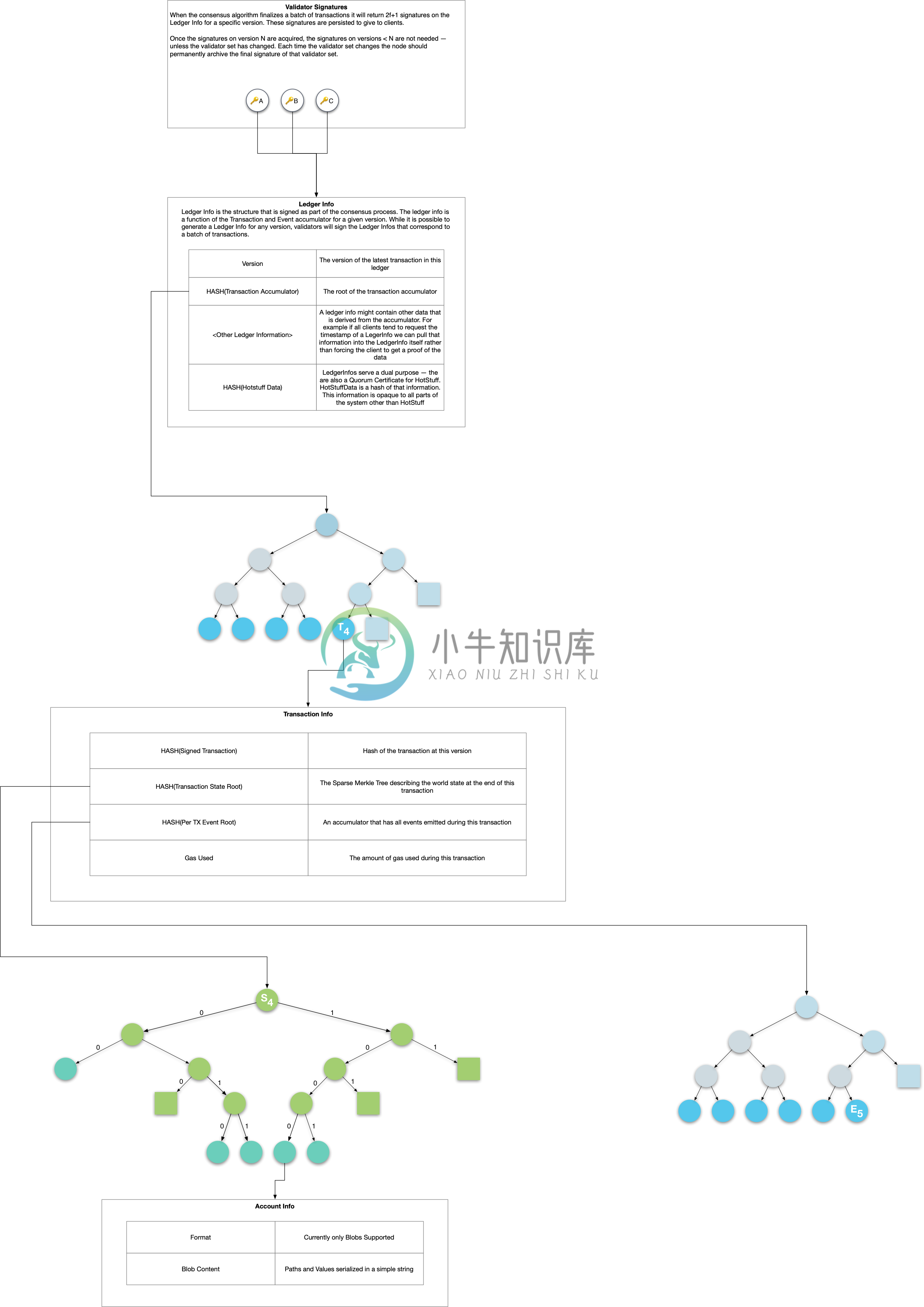Storage
The storage module provides reliable and efficient persistent storage for the entire set of data on the Libra Blockchain, as well as the necessary data used internally by Libra Core.
Overview
The storage module is designed to serve two primary purposes:
- Persist the blockchain data, specifically the transactions and their outputs that have been agreed by validators via consensus protocol.
- Provide a response with Merkle proofs to any query that asks for a part of the blockchain data. A client can easily verify the integrity of the response if they have obtained the correct root hash.
The Libra Blockchain can be viewed as a Merkle tree consisting of the following components:

Ledger History
Ledger history is represented by a Merkle accumulator. Each time a transaction T is added to the blockchain, a TransactionInfo structure containing the transaction T, the root hash for the state Merkle tree after the execution of T and the root hash for the event Merkle tree generated by T is appended to the accumulator.
Ledger State
The ledger state at each version is represented by a sparse Merkle tree that has the state of all accounts. The keys are the 256-bit hash of the addresses, and their corresponding value is the state of the entire account serialized as a binary blob. While a tree of size 2^256 is an intractable representation, subtrees consisting entirely of empty nodes are replaced with a placeholder value, and subtrees consisting of exactly one leaf are replaced with a single node.
While each TransactionInfo structure points to a different state tree, the new tree can reuse unchanged portion of the previous tree, forming a persistent data structure.
Events
Each transaction emits a list of events and those events form a Merkle accumulator. Similar to the state Merkle tree, the root hash of the event accumulator of a transaction is recorded in the corresponding TransactionInfo structure.
Ledger Info and Signatures
A LedgerInfo structure that has the root hash of the ledger history accumulator at some version and other metadata is a binding commitment to the ledger history up to this version. Validators sign the corresponding LedgerInfo structure every time they agree on a set of transactions and their execution outcome. For each LedgerInfo structure that is stored, a set of signatures on this structure from validators are also stored, so clients can verify the structure if they have obtained the public key of each validator.
Implementation Details
The storage module uses RocksDB as its physical storage engine. Since the storage module needs to store multiple types of data, and key-value pairs in RocksDB are byte arrays, there is a wrapper on top of RocksDB to deal with the serialization of keys and values. This wrapper enforces that all data in and out of the DB is structured according to predefined schemas.
The core module that implements the main functionalities is called LibraDB. While we use a single RocksDB instance to store the entire set of data, related data are grouped into logical stores — for example, ledger store, state store, and transaction store, etc.
For the sparse Merkle tree that represents ledger state, we optimize the disk layout by using branch nodes with 16 children that represents 4-level subtrees and extension nodes that represents a path without branches. However, we still simulate a binary tree when computing the root hash and proofs. This modification results in proofs that are shorter than the ones generated by Ethereum's Merkle Patricia tree.
How is this module organized?
storage
└── accumulator # Implementation of Merkle accumulator.
└── libradb # Implementation of LibraDB.
└── schemadb # Schematized wrapper on top of RocksDB.
└── scratchpad # In-memory representation of Libra core data structures used by execution.
└── sparse_merkle # Implementation of sparse Merkle tree.
└── state_view # An abstraction layer representing a snapshot of state where the Move VM reads data.
└── storage_client # A Rust wrapper on top of GRPC clients.
└── storage_proto # All interfaces provided by the storage module.
└── storage_service # Storage module as a GRPC service.

